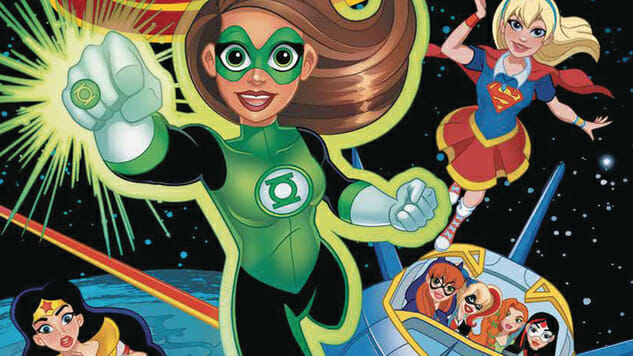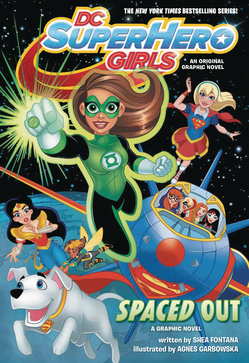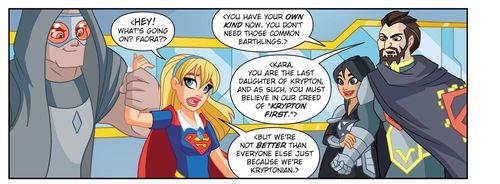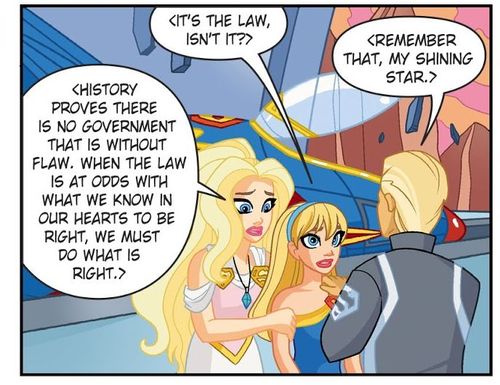DC Super Hero Girls Is an Ode to Silver-Age Joy
How This Grownup Man Fell in Love With DC's Kids Comics
Main Art by Yancy Labat Comics Features DC Super Hero Girls
 For those not yet familiar with the sensation, DC Super Hero Girls began life in 2015, as a mini-franchise consisting of animated web episodes, an action figure series and various other tie-ins—including original graphic novels and prose novels. The executive creators were Shea Fontana, Lisa Yee and Aria Moffly. You might guess the premise: the superheroines of DC Comics, from Wonder Woman and Batgirl to Katana and Bumblebee, star as teenagers in high school.
For those not yet familiar with the sensation, DC Super Hero Girls began life in 2015, as a mini-franchise consisting of animated web episodes, an action figure series and various other tie-ins—including original graphic novels and prose novels. The executive creators were Shea Fontana, Lisa Yee and Aria Moffly. You might guess the premise: the superheroines of DC Comics, from Wonder Woman and Batgirl to Katana and Bumblebee, star as teenagers in high school.
The voice talent of the cartoon is top-notch. The animation…looks as if it was procedurally generated by a computer. It reminds me of those random, creepy animated videos that snare little kids on YouTube. But the animation is not the whole story. It’s not even the beginning of the story. The action, as far as I’m concerned, happens in a different format. The cream of the DCSHG crop is its graphic novel line. I know what you’re thinking: “The tie-in comic-book version of an animated series that was based on comic books in the first place?” It sounds lame, like eating the shadow of a crow that ate the shadow of a peach. You might not think the comics would be worth it for readers outside of the core demographic of young girls. But in reality, the graphic novels are closer to the heart of what makes DCSHG so remarkable than any of the animated episodes.
I’m a grown-up man. The first time I discovered DCSHG was by accident, in a Target. When I picked up one of the tie-in books, I was a little skeptical. Comic-book adaptations of comic-book cartoons are hit-and-miss affairs. In adapting a story for animation, everything that comprises the original comic source material gets melted down and recast into new molds. Too often, the spin-off comics are phoned-in affairs. In my personal experience, truly great adaptations like the Batman: The Animated Series comic tie-in have been the exception, not the rule.
There are several explanations. Obviously, there’s a reason animation looks the way it does. Mainstream animation is typically simpler and more stylized than the art in modern superhero comics. Animation takes the relatively sleek, minimalist art of comic books…and simplifies it again. In the transition from comics to animation, eyes grow larger, lines grow fewer, colors become brighter. Whatever was stylized in the comic becomes more so in the animation. This isn’t an insult to animation, which is capable of incredible depth and power. It’s also fair to say that no medium is as hospitable to comics as cartoons. The two mediums are more like Mon-El and Kal-El than they are different species. But the stumbling blocks remain, and when I started reading DCSHG, I asked myself: what could DC Super Hero Girls give me that modern comics couldn’t?
Plenty.
The reason this essay exists at all is because the DCSHG comics are special. To be frank, I didn’t think the DCSHG graphic novels would be this good—at least from the perspective of an adult reader, someone who is already deeply fluent in superhero comics. If I see a gorilla with a handgun, I’m two lotto numbers away from maximum satori. I reread portions of DCSHG before diving into this essay, to make sure the stories still work, and to zero in on what turned me into a DCSHG hype monster in the first place. One story in particular stood out to me.

DC Super Hero Girls: Spaced Out Interior Art by Agnes Garbowska & Silvana Brys
Like all of the DCSHG narratives, Spaced Out is centered around Super Hero High, where all the titular Super Hero Girls attend classes and have their home base. This is also the ground floor for all of the relationships and personal tensions of the series. Spaced Out was written by series architect Shea Fontana, with art by Agnes Garbowska. The Spaced Out arc focuses on Jessica Cruz, one of DC’s newest Green Lanterns, and a teenager in this continuity. Cruz is forced to deal with her own insecurities as she ventures forth with a team of fellow heroes including Big Barda, Star Sapphire, Supergirl and Beast Boy. The group head off to find Oa, headquarters of the Green Lantern Corps.
When I started reading this book, I graded it on a curve: I would not criticize its obvious flaws too harshly. The need for charity didn’t last long. Here’s the wonder of DCSHG: it’s the Silver Age of DC Comics, reborn for a new generation, shrunken down, like Brainiac’s menagerie of miniaturized worlds. Without expecting to, while reading DCSHG, I stumbled on a pocket universe where the Silver Age still existed. It reminded me of why I liked superheroes in the first place.
My very first exposure to superheroes was probably like yours: my grandmother had a Spider-Man cereal bowl I used when I went over to her house. And at some point I became savvy about who Superman was. The very first superhero comic I remember reading—ever—is The Best of DC Vol. 1, #67. It was a digest copy, about the size of a slim paperback. If I recall, my mom bought it for me in December of 1985. The cover was an image of Starfinger shocking the absolute hell out of five members of the Legion of Super-Heroes. The story itself is a reprint of Adventure Comics #335, originally published in August 1965.
I need to stress this point: when I read The Best of DC, I had no idea what a Silver Age was. I had no idea, zero, that I was reading a 20-year-old comic. It seemed contemporary, recent. At most, I had a vague notion that the comic was somehow…older, but I didn’t know there had been a 1960s. The story felt fresh. I got a jolt from it that has not ceased, not to this day. There was a ludicrous, unstoppable delight. The characters dealt in big emotions and larger-than-life locales and problems. To borrow an apologist’s term, I was surprised by joy.
But my positive feelings for comics, and heroes, went deeper than pleasure. I felt like I’d tapped into the universal windlass of fiction. Betrayal, the future, mystery, amnesia, love breaking up the Legion, Brainiac being a total dick—The Best of DC had it all. That is the feeling I got again when I read DCSHG: the Silver Age.

DC Super Hero Girls: Spaced Out Interior Art by Agnes Garbowska & Silvana Brys
What do I mean by “The Silver Age?” Not the part where people turn into distorted versions of themselves with lion or ant heads. Not in the anti-Communist sense, or the questionable practical-joke sense, or in dream-logic sense. When I say DCSHG is like the Silver Age, I’m speaking of its earnestness, its plain, unironic (but still self-aware) rendering of superhero life. In its amenable good cheer, DCSHG is the closest I’ve gotten to the feeling I first had reading the postwar comics I loved, back when I first discovered superheroes.
As far as I’m concerned, though, “Silver Age” itself is a misnomer. When I read that first digest at the age of five, I simply thought that ‘60s Legion of Superheroes story was the way superhero comics—all of comics—just were. Spaced Out is nothing less than a reclamation of the elemental form of cape-and-cowl fiction. Spaced Out, Out of the Bottle, Finals Crisis and Search for Atlantis remind me of the reason I got into comics. DCSHG is the story of friendship, fulfilling your best potential and avoiding cultural chauvinism.
And, like the rest of the DCSHG books, Spaced Out has an emotional genius which is comparable to the best episodes of TV series like Community, as a shiny narrative is buttressed with emotional heft. In “Spaced Out,” why should I care about Flash’s petsitting jobs? Why should Supergirl’s internal struggle over Krypton’s legacy be so stressful? How is there depth to Star Sapphire, despite her surface role as spoiled rich girl? And yet, DCSHG communicates all of these complications, with an insight that borders on eerie.
The strange dynamic of primary-color-clad superhumans representing vital human emotions is central to the mystery of why superhero comics work. DCSHG gets it. After all, to read superhero stories, you have to consent to belief—which is the most basic form of vulnerability. The makers of this series understand that. The DCSHG story Search for Atlantis falls into this category too: it’s only partially a story about looking for a lost kingdom. The marrow of the tale deals with Bumblebee’s fears of being replaced by Wonder Woman’s new best friend, Mera. What will that mean for Bumblebee? And how does DCSHG convince the reader to care about this interpersonal concern as much as we care about the titular search for Atlantis?
I’m not claiming superhero comics have to be like this. Nostalgia is always a double-edged sword. Rather, what DCSHG and DC Comics’ Silver Age heyday represent is an expanded Overton Window for comics. If we accept that comics can handle deep, adult themes, if comics are the complex art form we say they are, then they are strong enough to bear all kinds of takes, including emotionally honest stories appropriate for readers young and old. Superhero comics is a mansion with many chambers, and DC Super Hero Girls more than earns its spot in one of them. There’s room for everyone. Everyone should be here.